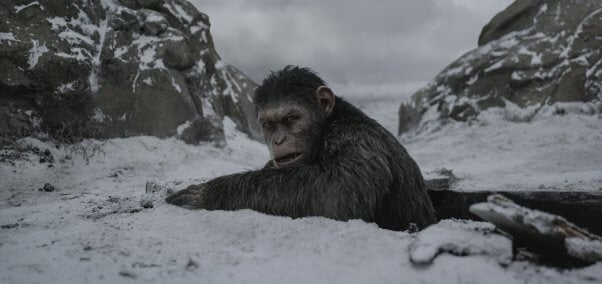‘War for the Planet of the Apes’ Spotlights the Power of CGI
Andy Serkis, Weta Digital, and the team behind the Planet of the Apes trilogy have done it again. War for the Planet of the Apes (the final film in 20th Century Fox’s reboot) is receiving many accolades—and not just for being an extremely entertaining science-fiction film. The motion picture proves that computer-generated imagery, or CGI, has no limits, offering powerful anti-captivity, pro–animal rights messages along the way.
In 2011, the visual effects team behind Rise of the Planet of the Apes broke new ground, using CGI to create apes who delivered a dramatic performance of unprecedented emotion and intelligence—no real apes were used during filming. Now, six years later, War is proving that the capabilities of CGI are only getting better and better. The visual effects used in the film are so spot-on and lifelike that audience members won’t even know that the apes aren’t real.
Thanks to revolutionary visual effects, Serkis—who is well known for his CGI portrayal of Gollum in The Lord of the Rings trilogy—transforms into Caesar, leader of the apes. Vanity Fair calls his performance a “truly dazzling feat,” saying, “In War, Caesar experiences grief and anger and hope and other big feelings, all rendered beautifully in a disarmingly effective marriage between actor and pixel.”
While the visual effects used in War are undeniably convincing and praiseworthy, we’re equally impressed with the film’s messaging. The movie demonstrates just how human-like these animals truly are—they share our emotions, they mourn the loss of loved ones, they miss their children when separated from them, and they feel joy, resentment, sadness, and rage. When asked why the Planet of the Apes franchise has resonated with audiences for nearly 50 years, director Matt Reeves said that it comes down to “seeing human nature expressed in the faces of these animals. It’s really a reminder that we are animals.”

There is nothing glamorous about showbiz for primates. Chimpanzees and orangutans used in entertainment are typically taken from their mothers shortly after birth—leaving both mother and baby with lifelong emotional scars. In order to force young apes to perform on cue, physical and psychological abuse are common.
Inaccurate portrayals of chimpanzees—such as when they’re used as human caricatures or displayed in unnatural environments—also have a negative impact on the species, which is endangered and which, according to Dr. Jane Goodall, may become extinct within our lifetime. War portrays apes in a much different way, reminding audiences, “Not all heroes are human.”
Highly intelligent, sensitive chimpanzees deserve better than to be treated as if they were props for our amusement, and we applaud the team behind the Planet of the Apes films for its stunning CGI characters. We expect that moviegoers will be as impressed as we are with the film’s visual effects and anti-captivity messaging, and we hope other producers follow suit.
Tell Other Productions That Animals Aren’t Actors
It seems that some productions didn’t get the memo: FOX’s Animal Control series starring Joel McHale shamelessly uses real animals as props and punchlines, making a mockery of the issues plaguing real animal control officers, who are swimming upstream in an ever-growing homeless-animal crisis. Urge FOX to stop using real animals on Animal Control:

